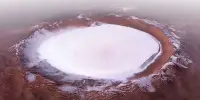The most convincing chemical proof of protoplanet formation to date has been found by researchers utilizing the Atacama Large Millimeter/submillimeter Array (ALMA) to explore the protoplanetary disk around a young star.
When direct observations or imaging are not feasible, the discovery will give astronomers a different way to find and describe protoplanets. The results will be published in an upcoming edition of The Astrophysical Journal Letters.
A young star called HD 169142 in the constellation Sagittarius is of great interest to astronomers because it has a massive, dense circumstellar disk that can be seen almost face-on.
Several protoplanet candidates have been identified over the last decade, and earlier this year, scientists at the University of Liège and Monash University confirmed that one such candidate HD 169142 b is, in fact, a giant Jupiter-like protoplanet.
Scientists may now find it simpler to identify protoplanets forming around young stars thanks to the findings revealed in a new analysis of archived data from ALMA, an international collaboration that includes the National Radio Astronomy Observatory (NRAO), a member of the National Science Foundation.
In addition to providing a new tool for planet-hunting with ALMA, this discovery opens up a lot of exciting chemistry that we’ve never seen before. As we continue to survey more disks around young stars, we will inevitably find other interesting but unanticipated molecules, just like SiS. Discoveries such as this imply that we are only just scratching the surface of the true chemical diversity associated with protoplanetary settings.
Charles Law
“When we looked at HD 169142 and its disk at submillimeter wavelengths, we identified several compelling chemical signatures of this recently-confirmed gas giant protoplanet,” said Charles Law, an astronomer at the Center for Astrophysics, Harvard & Smithsonian, and the lead author of the new study. “We now have confirmation that we can use chemical signatures to figure out what kinds of planets there might be forming in the disks around young stars.”
The team focused on the HD 169142 system because they believed that the presence of the HD 169142 b giant protoplanet was likely to be accompanied by detectable chemical signatures, and they were right.
Law’s team detected carbon monoxide (both 12CO and its isotopologue 13CO) and sulfur monoxide (SO), which had previously been detected and were thought to be associated with protoplanets in other disks. But for the first time, the team also detected silicon monosulfide (SiS).
This was unexpected because SiS emission must be emitted from close dust grains in large shock waves caused by gas moving at high speeds, a behavior normally coming from outflows powered by gigantic protoplanets, for SiS emission to be visible by ALMA.
“SiS was a molecule that we had never seen before in a protoplanetary disk, let alone in the vicinity of a giant protoplanet,” Law said. “The detection of SiS emission popped out at us because it means that this protoplanet must be producing powerful shock waves in the surrounding gas.”
Scientists may be expanding our knowledge of exoplanets and opening a new window on the universe with this novel chemical method for finding newborn protoplanets. Protoplanets offer a direct link to the known exoplanet population, especially those that are still enmeshed in their parental circumstellar disks, like in the HD 169142 system.
“There’s a huge diversity in exoplanets and by using chemical signatures observed with ALMA, this gives us a new way to understand how different protoplanets develop over time and ultimately connect their properties to that of exoplanetary systems,” said Law.
“In addition to providing a new tool for planet-hunting with ALMA, this discovery opens up a lot of exciting chemistry that we’ve never seen before. As we continue to survey more disks around young stars, we will inevitably find other interesting but unanticipated molecules, just like SiS. Discoveries such as this imply that we are only just scratching the surface of the true chemical diversity associated with protoplanetary settings.”
















